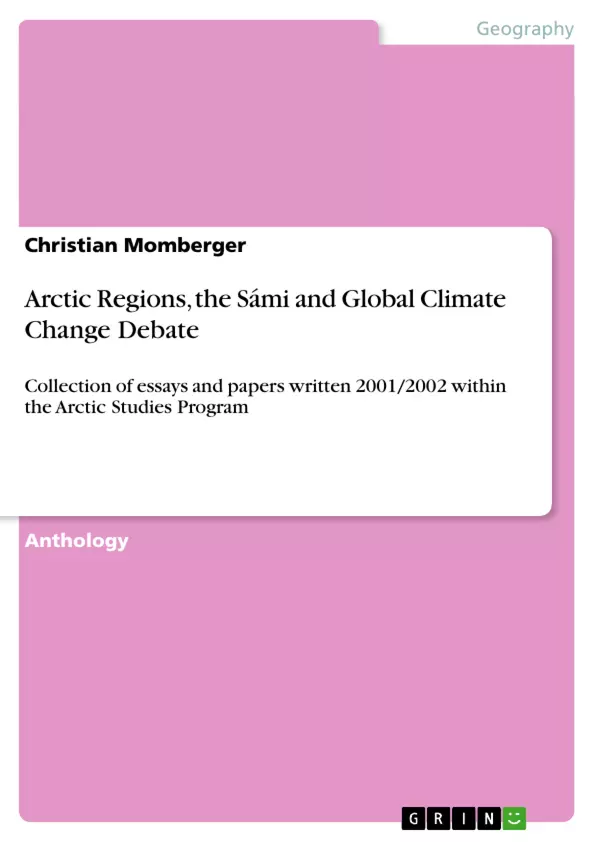From September 2001 till May 2002, the author studied within the Erasmus exchange program of the European Union two terms abroad at the University of Lapland (Lapin Yliopisto) in Rovaniemi/Finland. There he took part in the Arctic Studies Program (ASP). This is a very interdisciplinary program, offered by the Arctic Center (Arktinen Keskus) at the University of Lapland and covering many different topics. The ASP included lectures about the Arctic in general, about environmental issues, tourism, the Sami and indigenous people in general, social and economic development, politics and international relations and as well international law.
In this book, the essays and papers the author wrote and the presentations he hold within the ASP, are published. For this reason, the present book is a very interdisciplinary one, covering various topics concerning the arctic regions. The articles are divided into four subject areas: “Excursion to the North Calotte”, “The Sami and indigenous people in general”, “Environmental systems, economic development and sociology” and “Global Climate Change Debate”. “The collection of essays and papers written within in the Arctic Studies Program” is closed by the full timetables for both terms, given in the Annex. --- Von September 2001 bis Mai 2002, der Autor studierte zwei Semester an der University of Lapland (Lapin Yliopisto) in Rovaniemi/Finnland. Hier absolvierte er das Arctic Studies Program (ASP). Dies ist ein sehr interdisziplinäres Studienprogramm, welches Vorlesungen und Seminare zu den unterschiedlichsten Wissenschaftsbereichen beinhaltet. Themen waren u. a. die Arktischen Regionen ganz grundsätzlich, die Sami und die Ureinwohner im Allgemeinen, die wirtschaftliche und soziale Entwicklung, Umweltthemen, Tourismus und internationales Recht. In diesem Buch sind verschiedene Studienarbeiten und Referate, welche der Autor im Rahmen des ASP verfasst hat, veröffentlicht. Das vorliegende Buch ist daher ein sehr interdisziplinäres. Die darin enthaltenen Aufsätze sind in vier thematische Bereiche gegliedert. Im Anhang des Buches findet man die vollständigen „Stundenpläne“ für beide Semester des ASP.
Inhaltsverzeichnis (Table of Contents)
- Preface
- Part A Excursion the North Calotte
- The Glacial Landscape of Northern Scandinavia and the main vegetation zones of Finnish Lapland
- The Northern Society of Lapland: Impressions and Evaluations
- Sámi and their Culture
- Part B The Sámi and indigenous people in general
- The Assimilation Process and how Indigenous Societies try to face it
- The Sami as an Example
- The Sami Political Movement since the early 1970's
- Sami Culture and Modernisation - The Occupation of Reindeer Herding as an Example -
- The Definition of Indigenous People
- The Definition of "Indigenous People" - Are they like a normal minority? -
- Part C Environmental systems, economic development and sociology
- Changing land use and the causing feedbacks in the Arctic region
- Reindeer Herding vs. other Land Uses - A general overview about the Disturbances to Reindeer Herding -
- Facing Problems of Reindeer Herding - Environmental changes, human disturbances, economic pressures and the future of Reindeer Herding -
- Part D Global Climate Change Debate
- Persistent Organic Pollutants (POPs)
- Ozone Depletion and UV Radiation
- Air Pollution in the Arctic Region and its Impacts on Forests
- Global Climate Change, Boreal Forests and Indigenous Communities
- Part E Annex
- Timetable for the Arctic Studies Program: autumn term 2001
- Timetable for the Arctic Studies Program: spring term 2002
Zielsetzung und Themenschwerpunkte (Objectives and Key Themes)
This collection of essays and papers explores the Arctic region, its environmental systems, and the diverse cultures and societies that inhabit it. The work focuses on the Arctic Studies Program at the University of Lapland in Rovaniemi, Finland, showcasing the interdisciplinary nature of research in this field.- The impact of global climate change on Arctic environments and indigenous communities
- The history, culture, and political movements of the Sámi people
- The challenges faced by indigenous communities in the face of assimilation and modernization
- The importance of environmental protection and sustainable development in the Arctic region
- The role of interdisciplinary research in understanding and addressing complex Arctic issues
Zusammenfassung der Kapitel (Chapter Summaries)
- Part A: Excursion the North Calotte: This section examines the glacial landscape of Northern Scandinavia, focusing on the vegetation zones of Finnish Lapland. It also delves into the social and cultural aspects of northern Lapland, offering impressions and evaluations of the region's inhabitants.
- Part B: The Sámi and Indigenous People in General: This part explores the assimilation process faced by indigenous societies, using the Sámi people as a case study. It examines the political movement of the Sámi people since the early 1970s, highlighting their cultural practices and the challenges posed by modernization, particularly regarding reindeer herding.
- Part C: Environmental Systems, Economic Development and Sociology: This section focuses on the environmental impacts of changing land use in the Arctic region, including the challenges faced by reindeer herding in the face of other land use practices. It also explores the broader context of environmental change, human disturbances, economic pressures, and the future of reindeer herding.
- Part D: Global Climate Change Debate: This part examines the issue of global climate change from a northern perspective. It delves into the specific impacts of persistent organic pollutants (POPs), ozone depletion, and air pollution on Arctic ecosystems, with a particular emphasis on the consequences for boreal forests and indigenous communities.
Schlüsselwörter (Keywords)
The main keywords and focus topics of this work encompass the Arctic region, indigenous communities, climate change, environmental systems, social and economic development, and the Sámi people. The collection explores themes such as cultural preservation, political movements, assimilation, modernization, and interdisciplinary research. The text delves into the complexities of the Arctic region, highlighting the interconnectedness of its environment, culture, and politics.- Quote paper
- Dipl. Geogr. Christian Momberger (Author), 2002, Arctic Regions, the Sámi and Global Climate Change Debate, Munich, GRIN Verlag, https://www.grin.com/document/114799



